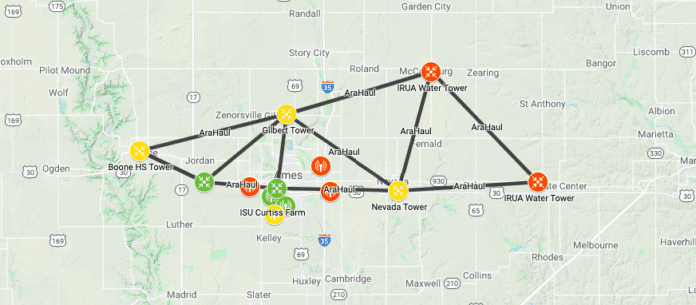A research wireless network testbed for rural broadband and related use cases will soon cover roughly 600 miles of central Iowa, including half a dozen communities, multiple school districts and the University of Iowa campus in Ames, Iowa.
The fourth and only rural testbed for the Platforms for Advanced Wireless Research (PAWR) program will focus on new strategies and technologies for expanding rural broadband, and uniquely rural applications for advanced wireless technologies.
The PAWR program already has three active testbeds: One in Salt Lake City, Utah with a software-defined, end-to-end wireless network and massive MIMO; one inWest Harlem in New York City, focused on mmwave research and innovation in backhaul technologies; and a third being built in the Research Triangle area of North Carolina that focuses on wireles communications and unmanned aerial vehicles. The National Science Foundation, which funds the $100 million PAWR program administered by US Ignite, announced the location of the fourth testbed, Agriculture and Rural Communities, or ARA, yesterday.
“ARA … specifically seeks novel solutions to reduce the cost and improve the availability of rural broadband, benefitting many underserved communities across the country,” said Dr. Margaret Martonosi, assistant director for the NSF’s Directorate for Computer and Information Science and Engineering, during a virtual event to announce the testbed. “Research conducted with ARA will create new possibilities for experimenting with broadband’s delivery models, designed to lower deployment costs and extend coverage in rural America.”
She added that the past year has particularly highlighted that rural communities were disproportionately affected by their lack of connectivity during the pandemic.
“Broadband isn’t just about internet access on its own, rather, it’s the key factor in developing and deploying innovative solutions in fields critical to our economy, like precision agriculture, education, health, cleaner energy, self-driving vehicles and much more,” Martonosi said, later adding, “ARA’s work makes me so very optimistic about our country’s overall push to close the digital divide and provide affordable broadband access for all.”
The US Department of Agriculture is contributing $1 million out of the $8 million for the testbed. Ericsson is an industry consortium partner for PAWR and already involved with the North Carolina testbed, which is in commissioning right now, according to Paul Challoner, VP of network product solutions for Ericsson North America, who also spoke during the virtual event.
“ARA provides really a unique opportunity to research 5G use cases,” Challoner said. Ericsson will be supplying commercial-grade equipment for the testbed. He mentioned potential use cases such as video-based identification of crop strains, tracking of livestock, automation ofarm management and the use of drones for precision agriculture applications such as crop spraying, weed identification and applying pesticides. Such an environment will need a mix of high, low and midband radio technologies and varying levels of coverage vs. capacity, Challoner said, and will need to be highly programmable. “It’s not really just the digital divide, or the homework gap; it’s really what we think about as a mobility gap,” Challoner added, because wide-area coverage is needed beyond rural residences.
According to PAWR, the ARA testbed will have a heterogeneous network environment including a “multi-modal, high-capacity wireless mesh network” for backhaul that includes Low Earth Orbit (LEO) satellite links, a free-space optical platform, long-distance millimeter-wave and microwave point-to-point. The RAN will use low-UHF massive MIMO and enable research across multiple bands, including CBRS, the TV white spaces and others.
Professor Hongwei Zhang of the University of Iowa, who is the principal investigator for ARA, said that “By supporting fundamental communication services such as ultra-reliable, low-latency communications, ARA enables field research studies (e.g., tele-operations of vehicles or drones) that are of generic interest to rural and urban regions but are difficult to conduct in urban settings in early stages of the exploration.”
The project team include researchers from the University of California, Irvine, Ohio State University, and International Computer Science Institute, and partners include the Iowa Communications Network (ICN), Iowa Department of Transportation (IDOT), Iowa Statewide Interoperable Communications System (ISICS), Iowa Regional Utilities Association (IRUA), Iowa Communications Alliance, the city of Ames, Story County, several local school districts, Meskwaki Tribal Nation, Woodland Farms, wireless network operator US Cellular, Collins Aerospace, and John Deere.

